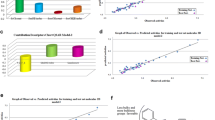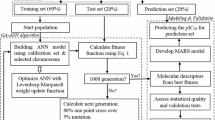Abstract
Imidazo[2,1-b][1,3,4]thiadiazoles have been recognized to possess antiproliferative potency towards a wide spectrum of cancer cell lines. QSAR investigations on a set of 42 di(tri)substituted imidazo[2,1-b][1,3,4]thiadiazoles were carried out to find the descriptors determining their biological potency. Three-variable equations were obtained by combinatorial protocols in multiple linear regression (CP MLR) for all three studied cancer cell lines. They showed that lipophilicity, electronic, and steric factors are decisive for the antiproliferative potency of compounds and indicate the important role of nitrogen atoms of imidazothiadiazole ring in the interactions with the molecular target. The best models gave high r squared values in the range from 0.887 to 0.924. They also have good predictive accuracy confirmed by the high value LOO cross-validation coefficient \(R_{\mathrm{CV}}^2 \) (from 0.842 to 0.904) and by the external validation quantities.
Graphical Abstract


Similar content being viewed by others
References
Joshi SD, Manish K, Badiger A (2013) Synthesis and evaluation of antibacterial and antitubercular activities of some novel imidazo[2,1-\(b\)][1,3,4]thiadiazole derivatives. Med Chem Res 22:869–878. doi:10.1007/s00044-012-0080-4
Chandrakantha B, Isloor AM, Shetty P, Fun HK, Hegde G (2014) Synthesis and biological evaluation of novel substituted 1,3,4-thiadiazole and 2,6-diaryl substituted imidazo[2,1-\(b\)][1,3,4]thiadiazole derivatives. Eur J Med Chem 71:316–323. doi:10.1016/j.ejmech.2013.10.056
Ramprasad J, Nayak N, Dalimba U, Yogeeswari P, Sriram D (2015) One-pot synthesis of new triazole-imidazo[2,1-\(b\)][1,3,4]thiadiazole hybrids via click chemistry and evaluation of their antitubercular activity. Bioorg Med Chem Lett 25:4169–4173. doi:10.1016/j.bmcl.2015.08.009
Jadhav VB, Kulkarni MV, Rasal VP, Biradar SS, Vinay MD (2008) Synthesis and anti-inflammatory evaluation of methylene bridged benzofuranyl imidazo[2,1-\(b\)][1,3,4]thiadiazoles. Eur J Med Chem 43:1721–1729. doi:10.1016/j.ejmech.2007.06.023
Gadad AK, Palkar MB, Arland K, Noolvi MN, Boreddy TS, Wagwade J (2008) Synthesis and biological evaluation of 2-trifluoromethyl/sulfonamido-5,6-diaryl substituted imidazo[2,1-\(b\)]-1,3,4-thiadiazoles: A novel class of cyclooxygenase-2 inhibitors. Bioorg Med Chem 16:276–283. doi:10.1016/j.bmc.2007.09.038
Romagnoli R, Baraldi PG, Prencipe F, Balzarini J, Liekens S, Estevez F (2015) Design, synthesis and antiproliferative activity of novel heterobivalent hybrids based on imidazo[2,1-\(b\)][1,3,4]thiadiazole and imidazo[2,1-\(b\)][1,3]thiazole scaffolds. Eur J Med Chem 101:205–217. doi:10.1016/j.ejmech.2015.06.042
Noolvi MN, Patel HM, Singh N, Gadad AK, Cameotra SS, Badiger A (2011) Synthesis and anticancer evaluation of novel 2-cyclopropylimidazo[2,1-\(b\)][1,3,4]-thiadiazole derivatives. Eur J Med Chem 246:4411–4418. doi:10.1016/j.ejmech.2011.07.012
Kumar S, Hegde M, Gopalakrishnan V, Renuka VK, Ramareddy SA, De Clercq E, Schols D, Narasimhamurthy AKG, Raghavan SC, Karki SS (2014) 2-(4-Chlorobenzyl)-6-arylimidazo[2,1-\(b\)][1,3,4]thiadiazoles: synthesis, cytotoxic activity and mechanism of action. Eur J Med Chem 84:687–697. doi:10.1016/j.ejmech.2014.07.054
Gireesh TM, Kamble RR, Taj T (2011) Synthesis and antimicrobial and anticancer activity of new of imidazo[2,1-\(b\)][1,3,4]thiadiazoles. Pharm Chem J 45:313–316. doi:10.1007/s11094-011-0624-9
Kamal A, Reddy VS, Santosh K, Kumar GB, Shaik AB, Mahesh R, Chourasiya SS, Sayeed IB, Kotamraju S (2014) Synthesis of imidazo[2,1-\(b\)][1,3,4]thiadiazole-chalcones as apoptosis inducing anticancer agents. Med Chem Comm 5:1718–1723. doi:10.1039/c4md00228h
Noolvi MN, Patel HM, Kamboj S, Kaur A, Mann V (2012) 2,6-Disubstituted imidazo[2,1-\(b\)][1,3,4]thiadiazoles: search for anticancer agents. Eur J Med Chem 56:56–69. doi:10.1016/j.ejmech.2012.08.012
Gadad AK, Karki SS, Rajurkar VG, Bhongade BA (1999) Synthesis and biological evaluation of 5-formyl-6-arylimidazo(2,1-b)-1,3,4-thiadiazole-2-N-(dimethylamino-methino) sulfonamides as antitumor agents. Arzneim Forsch 49:858–863
Taher AT, Georgey HH, EI-Subbagh HI (2012) Novel 1,3,4-heterodiazole analogues: synthesis and in vitro antitumor activity. Eur J Med Chem 47:445–451. doi:10.1016/j.ejmech.2011.11.013
Terzioglu N, Gursoy A (2003) Synthesis and anticancer evaluation of some new hydrazone derivatives of 2,6-dimethylimidazo[2,1-\(b\)][1,3,4]thiadiazole-5-carbohydrazide. Eur J Med Chem 38:781–786. doi:10.1016/S0223-5234(03)00138-7
Kumar S, Gopalakrishnan V, Hegde M, Rana V, Dhepe SS, Ramareddy SA, Leoni A, Locatelli A, Morigi R, Rambaldi M, Srivastava M, Raghavan SC, Karki SS (2014) Synthesis and antiproliferative activity of imidazo[2,1-\(b\)][1,3,4]thiadiazole derivatives. Bioorg Med Chem Lett 24:4682–4688. doi:10.1016/j.bmcl.2014.08.032
Karki SS, Panjamurthy K, Kumar S, Nambiar M, Ramareddy SA, Chiruvella KK, Raghavan SC (2011) Synthesis and biological evaluation of novel 2-aralkyl-5-substituted-6-(4’-fluorophenyl)-imidazo[2,1-\(b\)][1,3,4]thiadiazole derivatives as potent anticancer agents. Eur J Med Chem 46:2109–2116. doi:10.1016/j.ejmech.2011.02.064
Molina-Ruiz R, Saiz-Urra L, Rodriguez-Borges JE, Perez-Castillo Y, Gonzalez MP, Garcia-Mera X, Cordeiro MNDS (2009) A TOPological sub-structural molecular design (TOPS-MODE)-QSAR approach for modeling the antiproliferative activity against murine leukemia tumor cell line (L1210). Bioorg Med Chem 17:537–547. doi:10.1016/j.bmc.2008.11.084
Vujasinovic I, Paravic-Radicevic A, Mlinaric-Majerski K, Brajsa K, Bertosa B (2012) Synthesis and biological validation of novel pyrazole derivatives with anticancer activity guided by 3D-QSAR analysis. Bioorg Med Chem 20:2101–2110. doi:10.1016/j.bmc.2012.01.032
George RF, Ismail NSM, Stawinski J, Girgis AS (2013) Design, synthesis and QSAR studies of dispiroindole derivatives as new antiproliferative agents. Eur J Med Chem 68:339–351. doi:10.1016/j.ejmech.2013.07.035
Singh R, Jain A, Ravichandran V, Mourya V, Agrawal RK (2009) Prediction of antiproliferative activity of some flavone derivatives: QSAR study. Med Chem Res 18:523–537. doi:10.1007/s00044-008-9146-8
Matysiak J (2008) QSAR of antiproliferative activity of N-substituted 2-amino-5-(2,4-dihydroxyphenyl)-1,3,4-thiadiazoles in various human cancer cells. QSAR Comb Sci 27:607–617. doi:10.1002/qsar.200610157
Carballo RM, Leon LG, Quijano-Quinones RF, Mena-Rejon GJ, Martin VS, Padron JM, Padron JI (2014) Antiproliferative evaluation of N-sulfonyl-2-alkyl-six membered azacycles. A QSAR study. Med Chem 10:571–579. doi:10.2174/1573406409666131124231552
Yao SW, Lopes VH, Fernandez F, Garcia-Mera X, Morales M, Rodriguez-Borges JE, Cordeiro MN (2003) Synthesis and QSAR study of the anticancer activity of some novel indane carbocyclic nucleosides. Bioorg Med Chem 11:4999–5006. doi:10.1016/j.bmc.2003.09.005
Verma RP, Hansch C (2004) Elucidation of structure-activity relationships for 2- or 6-substituted-5,8-dimethoxy-1,4-naphthoquinones. Bioorg Med Chem 12:5997–6009. doi:10.1016/j.bmc.2004.08.017
Mekapati SB, Denny WA, Kurup A, Hansch C (2001) QSAR of anticancer compounds. Bis(11-oxo-11\(H\)-indeno[1,2-\(b\)]quinoline-6-carboxamides), bis(phenazine-1-carboxamides), and bis(naphthalimides). Bioorg Med Chem 9:2757–2762. doi:10.1016/S0968-0896(01)00109-2
Markovic V, Eric S, Stanojkovic T, Gligorijevic N, Arandelovic S, Todorovic N, Trifunovic S, Manojlovic N, Jelic R, Joksovic MD (2011) Antiproliferative activity and QSAR studies of a series of new 4-aminomethylidene derivatives of some pyrazol-5-ones. Bioorg Med Chem Lett 21:4416–4421. doi:10.1016/j.bmcl.2011.06.025
Cvijetic IN, Zizak ZP, Stanojkovic TP, Juranic ZD, Terzic N, Opsenica IM, Opsenica DM, Juranic IO, Drakulic BJ (2010) An alignment independent 3D QSAR study of the antiproliferative activity of 1,2,4,5-tetraoxanes. Eur J Med Chem 45:4570–4577. doi:10.1016/j.ejmech.2010.07.019
Matysiak J, Niewiadomy A, Paw B, Dybala I (2011) NMR QSAR model for the analysis of 4-(5-arylamino-1,3,4-thiadiazol-2-yl)benzene-1,3-diols. Arch Pharm 344:340–344. doi:10.1002/ardp.201000029
Duchowicz PR, Bennardi DO, Bacelo DE, Bonifazi EL, Rios-Luci C, Padron JM, Burton G, Misico RI (2014) QSAR on antiproliferative naphthoquinones based on a conformation-independent approach. Eur J Med Chem 77:176–184. doi:10.1016/j.ejmech.2014.02.057
Masand VH, Mahajan DT, Alafeefy AM, Bukhari SNA, Elsayed NN (2015) Optimization of antiproliferative activity of substituted phenyl 4-(2-oxoimidazolidin-1-yl) benzenesulfonates: QSAR and CoMFA analyses. Eur J Pharm Sci 77:230–237. doi:10.1016/j.ejps.2015.06.001
Moriguchi I, Hirono S, Nakagome I, Hirano H (1994) Comparison of reliability of log P values for drugs calculated by several methods. Chem Pharm Bull 42:976–978. doi:10.1248/cpb.42.976
Ghose AK, Crippen GM (1987) Atomic physicochemical parameters for three-dimensional-structure-directed quantitative structure-activity relationships. 2. Modeling dispersive and hydrophobic interactions. J Chem Inf Comput Sci 27:21–35. doi:10.1021/ci00053a005
Thanikaivelan P, Subramanian V, Rao JR, Nair BU (2000) Application of quantum chemical descriptor in quantitative structure activity and structure property relationship. Chem Phys Lett 323:59–70. doi:10.1016/S0009-2614(00)00488-7
QSAR Model Development Using DTC Lab. Software Tools. http://teqip.jdvu.ac.in/QSAR_Tools/ (licence agreement)
Roy PP, Paul S, Mitra I, Roy K (2009) On two novel parameters for validation of predictive QSAR models. Molecules 14:1660–1701. doi:10.3390/molecules14051660
Leonard JT, Roy K (2006) On selection of training and test sets for the development of predictive QSAR models. QSAR Comb Sci 25:235–251. doi:10.1002/qsar.200510161
Golbraikh A, Tropsha A (2002) Beware of q(2)!. J Mol Graph Model 20:269–276. doi:10.1016/S1093-3263(01)00123-1
Roy K, Kar S (2014) The \(r_{m}^{2}\) metrics and regression through origin approach: reliable and useful validation tools for predictive QSAR models (Commentary on ‘Is regression through origin useful in external validation of QSAR models?’). Eur J Pharm Sci 62:111–114. doi:10.1016/j.ejps.2014.05.019
Hansch C, Clayton JM (1973) Lipophilic character and biological activity of drugs II: the parabolic case. J Pharm Sci 61:1–21
McKeage MJ, Berners-Price SJ, Galettis P, Bowen RJ, Brouwer W, Ding L, Zhuang L, Baguley BC (2000) Role of lipophilicity in determining cellular uptake and antitumour activity of gold phosphine complexes. Cancer Chemother Pharmacol 46:343–50. doi:10.1007/s002800000166
Spartan 10 (2011) Wavefunction Inc, California, USA. http://www.wavefun.com
ACD/ChemSketch 11.02 (2008) Advanced Chemistry Development, Inc., Toronto, Canada. http://www.acdlabs.com
MedChem Designer 3.0 (2014) Simulations Plus, Inc, Lancaster, California, USA., http://www.simulations-plus.com
Gupta MK, Prabhakar YS (2006) Topological descriptors in modeling the antimalarial activity of 4-(3’,5’-disubstituted anilino)quinolines. J Chem Inf Model 46:93–102. doi:10.1021/ci0501140
Saquib M, Gupta MK, Sagar R, Prabhakar YS, Shaw AK, Kumar R, Maulik PR, Gaikwad AN, Sinha S, Srivastava AK, Chaturvedi V, Srivastava R, Srivastava BS (2007) C-3 alkyl/arylalkyl-2,3-dideoxy hex-2-enopyranosides as antitubercular agents: synthesis, biological evaluation, and QSAR study. J Med Chem 50:2942–2950. doi:10.1021/jm070110h
Gaudio AC (2009) BuildQSAR. 2.1.0.0. Federal University of Espírito Santo, Brazil. http://www.profanderson.net
de Oliveira DB, Gaudio AC (2001) BuildQSAR: a new computer program for QSAR analysis. Quant Struct Act Rel 19:599–601. doi:10.1002/1521-3838(200012)19:6<599:AID-QSAR599>3.0.CO;2-B
Statistica 7.1 (2005) StatSoft Inc, Tulsa, OK, USA. http://www.statsoft.pl
Author information
Authors and Affiliations
Corresponding author
Electronic supplementary material
Below is the link to the electronic supplementary material.
Rights and permissions
About this article
Cite this article
Matysiak, J., Niewiadomy, A. QSAR models of antiproliferative activity of imidazo[2,1-b][1,3,4]thiadiazoles in various cancer cell lines. Mol Divers 21, 211–218 (2017). https://doi.org/10.1007/s11030-016-9705-8
Received:
Accepted:
Published:
Issue Date:
DOI: https://doi.org/10.1007/s11030-016-9705-8




